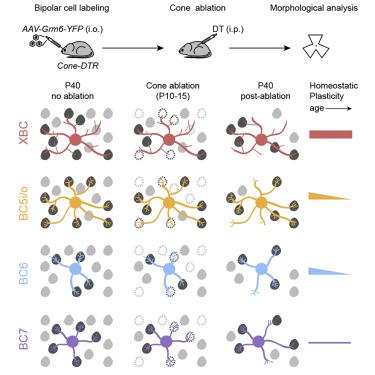当前位置:
X-MOL 学术
›
Curr. Biol.
›
论文详情
Our official English website, www.x-mol.net, welcomes your feedback! (Note: you will need to create a separate account there.)
Homeostatic Plasticity Shapes the Retinal Response to Photoreceptor Degeneration.
Current Biology ( IF 9.2 ) Pub Date : 2020-04-02 , DOI: 10.1016/j.cub.2020.03.033 Ning Shen 1 , Bing Wang 1 , Florentina Soto 1 , Daniel Kerschensteiner 2
Current Biology ( IF 9.2 ) Pub Date : 2020-04-02 , DOI: 10.1016/j.cub.2020.03.033 Ning Shen 1 , Bing Wang 1 , Florentina Soto 1 , Daniel Kerschensteiner 2
Affiliation

|
Homeostatic plasticity stabilizes input and activity levels during neural development, but whether it can restore connectivity and preserve circuit function during neurodegeneration is unknown. Photoreceptor degeneration is the most common cause of blindness in the industrialized world. Visual deficits are dominated by cone loss, which progresses slowly, leaving a window during which rewiring of second-order neurons (i.e., bipolar cells) could preserve function. Here we establish a transgenic model to induce cone degeneration with precise control and analyze bipolar cell responses and their effects on vision through anatomical reconstructions, in vivo electrophysiology, and behavioral assays. In young retinas, we find that three bipolar cell types precisely restore input synapse numbers when 50% of cones degenerate but one does not. Of the three bipolar cell types that rewire, two contact new cones within stable dendritic territories, whereas one expands its dendrite arbors to reach new partners. In mature retinas, only one of four bipolar cell types rewires homeostatically. This steep decline in homeostatic plasticity is accompanied by reduced light responses of bipolar cells and deficits in visual behaviors. By contrast, light responses and behavioral performance are preserved when cones degenerate in young mice. Our results reveal unexpected cell type specificity and a steep maturational decline of homeostatic plasticity. The effect of homeostatic plasticity on functional outcomes identify it as a promising therapeutic target for retinal and other neurodegenerative diseases.
中文翻译:

稳态可塑性塑造视网膜对光感受器退化的反应。
稳态可塑性在神经发育过程中稳定输入和活动水平,但它是否能在神经变性过程中恢复连接并保持电路功能尚不清楚。光感受器变性是工业化世界中最常见的失明原因。视觉缺陷主要是视锥细胞丢失,它进展缓慢,留下一个窗口,在此期间二阶神经元(即双极细胞)的重新布线可以保持功能。在这里,我们建立了一个转基因模型,以精确控制诱导锥体变性,并通过解剖重建、体内电生理学和行为分析分析双极细胞反应及其对视力的影响。在年轻的视网膜中,我们发现当 50% 的视锥细胞退化但一种没有退化时,三种双极细胞类型精确地恢复了输入突触数量。在重新连接的三种双极细胞类型中,两种接触稳定树突区域内的新锥体,而一种扩展其树突乔木以接触新伙伴。在成熟的视网膜中,四种双极细胞类型中只有一种会自我平衡地重新布线。这种稳态可塑性的急剧下降伴随着双极细胞的光反应减弱和视觉行为缺陷。相比之下,当年轻小鼠的视锥细胞退化时,光反应和行为表现得以保留。我们的结果揭示了意想不到的细胞类型特异性和稳态可塑性的急剧成熟下降。稳态可塑性对功能结果的影响使其成为视网膜和其他神经退行性疾病的有希望的治疗靶点。而一个扩展其树突乔木以接触新的合作伙伴。在成熟的视网膜中,四种双极细胞类型中只有一种会自我平衡地重新布线。这种稳态可塑性的急剧下降伴随着双极细胞的光反应减弱和视觉行为缺陷。相比之下,当年轻小鼠的视锥细胞退化时,光反应和行为表现得以保留。我们的结果揭示了意想不到的细胞类型特异性和稳态可塑性的急剧成熟下降。稳态可塑性对功能结果的影响使其成为视网膜和其他神经退行性疾病的有希望的治疗靶点。而一个扩展其树突乔木以接触新的合作伙伴。在成熟的视网膜中,四种双极细胞类型中只有一种会自我平衡地重新布线。这种稳态可塑性的急剧下降伴随着双极细胞的光反应减弱和视觉行为缺陷。相比之下,当年轻小鼠的视锥细胞退化时,光反应和行为表现得以保留。我们的结果揭示了意想不到的细胞类型特异性和稳态可塑性的急剧成熟下降。稳态可塑性对功能结果的影响使其成为视网膜和其他神经退行性疾病的有希望的治疗靶点。这种稳态可塑性的急剧下降伴随着双极细胞的光反应减弱和视觉行为缺陷。相比之下,当年轻小鼠的视锥细胞退化时,光反应和行为表现得以保留。我们的结果揭示了意想不到的细胞类型特异性和稳态可塑性的急剧成熟下降。稳态可塑性对功能结果的影响使其成为视网膜和其他神经退行性疾病的有希望的治疗靶点。这种稳态可塑性的急剧下降伴随着双极细胞的光反应减弱和视觉行为缺陷。相比之下,当年轻小鼠的视锥细胞退化时,光反应和行为表现得以保留。我们的结果揭示了意想不到的细胞类型特异性和稳态可塑性的急剧成熟下降。稳态可塑性对功能结果的影响使其成为视网膜和其他神经退行性疾病的有希望的治疗靶点。
更新日期:2020-04-02
中文翻译:

稳态可塑性塑造视网膜对光感受器退化的反应。
稳态可塑性在神经发育过程中稳定输入和活动水平,但它是否能在神经变性过程中恢复连接并保持电路功能尚不清楚。光感受器变性是工业化世界中最常见的失明原因。视觉缺陷主要是视锥细胞丢失,它进展缓慢,留下一个窗口,在此期间二阶神经元(即双极细胞)的重新布线可以保持功能。在这里,我们建立了一个转基因模型,以精确控制诱导锥体变性,并通过解剖重建、体内电生理学和行为分析分析双极细胞反应及其对视力的影响。在年轻的视网膜中,我们发现当 50% 的视锥细胞退化但一种没有退化时,三种双极细胞类型精确地恢复了输入突触数量。在重新连接的三种双极细胞类型中,两种接触稳定树突区域内的新锥体,而一种扩展其树突乔木以接触新伙伴。在成熟的视网膜中,四种双极细胞类型中只有一种会自我平衡地重新布线。这种稳态可塑性的急剧下降伴随着双极细胞的光反应减弱和视觉行为缺陷。相比之下,当年轻小鼠的视锥细胞退化时,光反应和行为表现得以保留。我们的结果揭示了意想不到的细胞类型特异性和稳态可塑性的急剧成熟下降。稳态可塑性对功能结果的影响使其成为视网膜和其他神经退行性疾病的有希望的治疗靶点。而一个扩展其树突乔木以接触新的合作伙伴。在成熟的视网膜中,四种双极细胞类型中只有一种会自我平衡地重新布线。这种稳态可塑性的急剧下降伴随着双极细胞的光反应减弱和视觉行为缺陷。相比之下,当年轻小鼠的视锥细胞退化时,光反应和行为表现得以保留。我们的结果揭示了意想不到的细胞类型特异性和稳态可塑性的急剧成熟下降。稳态可塑性对功能结果的影响使其成为视网膜和其他神经退行性疾病的有希望的治疗靶点。而一个扩展其树突乔木以接触新的合作伙伴。在成熟的视网膜中,四种双极细胞类型中只有一种会自我平衡地重新布线。这种稳态可塑性的急剧下降伴随着双极细胞的光反应减弱和视觉行为缺陷。相比之下,当年轻小鼠的视锥细胞退化时,光反应和行为表现得以保留。我们的结果揭示了意想不到的细胞类型特异性和稳态可塑性的急剧成熟下降。稳态可塑性对功能结果的影响使其成为视网膜和其他神经退行性疾病的有希望的治疗靶点。这种稳态可塑性的急剧下降伴随着双极细胞的光反应减弱和视觉行为缺陷。相比之下,当年轻小鼠的视锥细胞退化时,光反应和行为表现得以保留。我们的结果揭示了意想不到的细胞类型特异性和稳态可塑性的急剧成熟下降。稳态可塑性对功能结果的影响使其成为视网膜和其他神经退行性疾病的有希望的治疗靶点。这种稳态可塑性的急剧下降伴随着双极细胞的光反应减弱和视觉行为缺陷。相比之下,当年轻小鼠的视锥细胞退化时,光反应和行为表现得以保留。我们的结果揭示了意想不到的细胞类型特异性和稳态可塑性的急剧成熟下降。稳态可塑性对功能结果的影响使其成为视网膜和其他神经退行性疾病的有希望的治疗靶点。



























 京公网安备 11010802027423号
京公网安备 11010802027423号